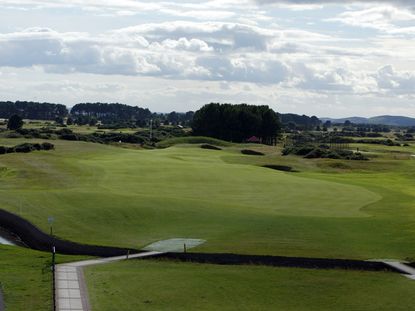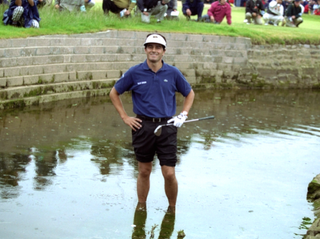Amateur Championship turns spotlight on Carnoustie
The Amateur Championship will be held in Carnoustie from June 15th to 20th


This June's Amateur Championship will be the first of several major competitions to be hosted at Carnoustie over the coming years.
When the Amateur Championship returns to Carnoustie this June it will be the first of several prestigious competitions to be hosted on the great Angus links over the next few years.
288 of the world’s best amateurs will contest the 120th Amateur Championship at Carnoustie and Panmure between the 15th and 20th of June. The Senior Open Championship will be held at Carnoustie in 2016 for a second time and The Open Championship will return to the famous links for an eighth time in 2018.
The Amateur Championship was last played at Carnoustie in 1992 when home player Stephen Dundas was the victor – he beat current European Tour player Bradley Dredge by 7&6 in a rather one-sided final. In 2014, another Scotsman took the biggest prize in amateur golf: Blairgowrie’s Bradley Neil won the title at Royal Portrush.
The Amateur Championship offers significant spoils to the victor. Provided he stays an amateur, the winner will gain spots in the following month’s Open Championship at St Andrews, as well as the 2016 U.S. Masters and U.S. Open. Bradley Neil tees it up in Augusta this week.
Carnoustie’s Championship course will provide a stern test for the competitors this June. Featuring firm, sandy soil and undulating terrain, it is a course with true links playing characteristics. With its magnetic pot bunkers, perplexing swales and humps, meandering burns and the occasional threat of out-of-bounds, the course is as difficult as any you’ll find around the UK’s coastline.
The run for home is particularly tough and has been the undoing of many great players over the years. The 16th is a monster par-3 that can be stretched to 250 yards. With the wind against, the players in the Amateur will be forlornly searching their bags for a kitchen sink to throw at the ball.
Get the Golf Monthly Newsletter
Subscribe to the Golf Monthly newsletter to stay up to date with all the latest tour news, equipment news, reviews, head-to-heads and buyer’s guides from our team of experienced experts.
The 17th is a formidable par-4 requiring a strategic approach. The Barry Burn snakes twice across the fairway and you must decide whether the wind is helping, or you feel strong enough to carry both sections. If not, a lay-up is required but that will leave a long and difficult shot to a sloping green.
It was on this hole in The Open Championship of 2007 that Andres Romero lost his chance of victory. The Argentinian was leading, having made 10 birdies in his round, but he shanked his second to the 17th and made a double bogey, he then bogeyed the last to miss a playoff with Padraig Harrington and Sergio Garcia by a single shot.
Carnoustie can be cruel and there’s no more pertinent example of that than the 18th hole. Another par-4, it’s often played into the breeze. Again, the Barry Burn is a threat, this time on both drive and approach. In 2007, Harrington found the burn twice on the 72nd hole but somehow scrambled a six. That was enough to force a playoff with Garcia when the Spaniard’s par putt on the final green defied gravity and refused to drop. The Irishman went on to win The Claret Jug for the first time.

In 1999, Jean Van de Velde endured one of the biggest meltdowns in golfing history on Carnoustie’s 18th hole. Leading The Open by three with one to play, his tee shot was flayed right, but it did stay dry. Using a form of logic, he aimed his second shot at the grandstand on the right side, thinking the likely result would be a visit to a dropping zone. But his ball ricocheted off a small square of metal and bounced back into thick rough. From there he hacked at the ball hopefully but it ended in the Barry Burn. He took his shoes and socks off and got down in the water, contemplating playing it. He thought better of it, took a drop then chopped it into the greenside bunker. From there, he did brilliantly to get up-and-down and force a playoff with Paul Lawrie and Justin Leonard. But he was emotionally spent and the victory went to Lawrie. The Scot had started the day 10 shots behind the Frenchman.
This is a course that always produces drama. So this year’s Amateur Championship looks set to be a cracker. Entry into the event is granted to the most qualified 288 applicants from around the world, with approximately half the slots reserved for players from the UK and Ireland.
The first part of the tournament will be 36-holes of strokeplay, one round at Carnoustie, one at Panmure down the road. The leading 64 players over those rounds will then go through to the knockout stages. Matches will be over 18 holes on Carnoustie’s Championship course with a 36-hole final.
One of the finest links in Britain, Carnoustie’s Championship course was placed 6th in Golf Monthly’s most recent Top-100 courses list. But Carnoustie is also blessed to have two further wonderful courses that both locals and visitors enjoy: The Burnside and the Buddon.
The Burnside is a fabulous layout and a track that would, perhaps, get more recognition if it weren’t set in the shadow of its famous bigger brother. It may measure less than 6,000 yards, but the test presented by the Burnside is exacting. The fairways are narrow and the greens exceedingly tricky.
The short holes on The Burnside deserve special mention and the 5th in particular. Its name “Burn” gives the game away somewhat, but doesn’t tell the full story. The Barry Burn circles the green and surrounds it on three sides. This one requires a brave and precise shot.
The Buddon has traditionally been thought of as the third of Carnoustie’s three courses, but for last season it was re-vamped, its length increased from 5,420 yards to 6,088 yards and the par raised from 65 to 68. Mackenzie and Ebert course architects oversaw a £600,000 re-design that has included the addition of two new par 4s at the far end of the course.
Like the Burnside (and the Championship for that matter) the Buddon demands a high degree of accuracy. A number of holes are tree-lined and others have streams or ponds bounding them. The new holes provide an excellent new dimension to this course. The 11th “The Hook,” fittingly, turns to the left with water all down the right side, then the 12th “St Valery” turns in the other direction with trouble, once again, lurking all down the right.
Something to the great credit of the greenkeepers at Carnoustie is the consistency of the playing surfaces. You can go out and play the Championship one day, the Burnside the next and then the Buddon and you’ll find yourself putting on greens of the same quality and speed. That’s great for a golfing break – get the feel on day one and it will stay with you for the duration. And Carnoustie is a perfect destination for a short golfing break – A brutish Open venue with incredible history, presenting a challenge for even the most accomplished players, backed up by two wonderful shorter tracks that won’t beat you up quite as viciously as big brother, but they’ll certainly make you think.

Fergus is Golf Monthly's resident expert on the history of the game and has written extensively on that subject. He is a golf obsessive and 1-handicapper. Growing up in the North East of Scotland, golf runs through his veins and his passion for the sport was bolstered during his time at St Andrews university studying history. He went on to earn a post graduate diploma from the London School of Journalism. Fergus has worked for Golf Monthly since 2004 and has written two books on the game; "Great Golf Debates" together with Jezz Ellwood of Golf Monthly and the history section of "The Ultimate Golf Book" together with Neil Tappin , also of Golf Monthly.
Fergus once shanked a ball from just over Granny Clark's Wynd on the 18th of the Old Course that struck the St Andrews Golf Club and rebounded into the Valley of Sin, from where he saved par. Who says there's no golfing god?
-
 YouTube Star George Bryan Comes Within Inches Of PGA Tour Start At Qualifying Event
YouTube Star George Bryan Comes Within Inches Of PGA Tour Start At Qualifying EventThe YouTube star appeared set for a place at the Myrtle Beach Classic, but a near miss on the 18th left him in a playoff, which Matt Atkins won
By Mike Hall Published
-
 6 Mistakes Golfers Make When Choosing A Putter
6 Mistakes Golfers Make When Choosing A PutterJoe Ferguson examines how you can avoid some common pitfalls the next time you look to change putters
By Joe Ferguson Published